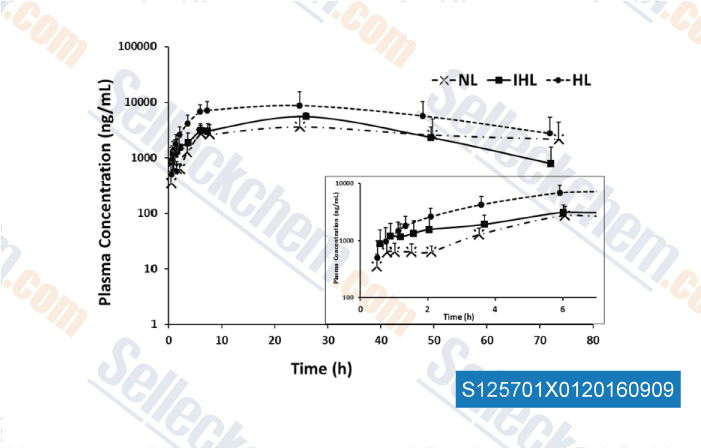|
Toll Free: (877) 796-6397 -- USA and Canada only -- |
Fax: +1-832-582-8590 Orders: +1-832-582-8158 |
Tech Support: +1-832-582-8158 Ext:3 Please provide your Order Number in the email. |
Technical Data
| Formula | C37H42F2N8O4 |
|||
| Molecular Weight | 700.78 | CAS No. | 171228-49-2 | |
| Solubility (25°C)* | In vitro | DMSO | 100 mg/mL (142.69 mM) | |
| Water | Insoluble | |||
| Ethanol | Insoluble | |||
|
* <1 mg/ml means slightly soluble or insoluble. * Please note that Selleck tests the solubility of all compounds in-house, and the actual solubility may differ slightly from published values. This is normal and is due to slight batch-to-batch variations. * Room temperature shipping (Stability testing shows this product can be shipped without any cooling measures.) |
||||
Preparing Stock Solutions
Biological Activity
| Description | Posaconazole is an inhibitor primarily of CYP3A4, but it does not inhibit the activity of other CYP enzymes; Also an inhibitor of sterol C14ɑ demethylase inhibitor with IC50 of 0.25 μM. Posaconazole has a median terminal elimination half-life of 15-35 hours. | ||
|---|---|---|---|
| Targets |
|
||
| In vitro | Posaconazole has potent trypanocidal activity. Amiodarone acts synergistically with Posaconazole. Posaconazole also affects and disrupts Ca2+ homeostasis in T. cruzi. Posaconazole blocks the biosynthesis of ergosterol, which is essential for parasite survival. Posaconazole has a clear, dose-dependent effect on proliferation of the epimastigote (extracellular) stages, with a minimal inhibitory concentration of 20 nM and an IC50 of 14 nM. Against the clinically relevant intracellular amastigote form of the parasite, Posaconazole is even more potent. Posaconazole has the minimal inhibitory concentration and IC50 values of 3 nM and 0.25 nM. [1] Posaconazole is active against isolates of Candida and Aspergillus spp. that exhibit resistance to Fluconazole, Voriconazole, and Amphotericin B and is much more active than the other triazoles against zygomycetes. [2] |
||
| In vivo | Treatment of infected animals with amiodarone alone reduces parasitemia, increases survival 60 days pi (0% for untreated controls vs 40% for amiodarone-treated animals) and, when given in combination with Posaconazole, delays the development of parasitemia. [1] Coadministration of Posaconazole and Boost Plus increases drug exposure compared to the administration of Posaconazole alone in the fasted state. Food, particularly meals high in fat content, significantly increases Posaconazole bioavailability. Systemic exposure to Posaconazole increases 4- and 2.6-fold when it is consumed with a high-fat and nonfat meal, respectively. [3] Posaconazole and Amiodarone may constitute an effective anti-T. cruzi therapy with low side effect. [4] At twice-daily doses of ≥15 mg/kg of body weight, Posaconazole prolongs the survival of the mice and reduces tissue burden. [5] |
||
| Features | Currently the most advanced candidate for the treatment of Chagas disease. |
Protocol (from reference)
| Cell Assay: |
|
|---|---|
| Animal Study: |
|
References
Customer Product Validation

-
Data from [Data independently produced by , , Eur J Pharm Sci, 2016, 91:190-195. ]
Selleck's Posaconazole has been cited by 28 publications
| Pyrvinium Pamoate Synergizes with Azoles in vitro and in vivo to Exert Antifungal Efficacy Against Candida auris and Other Candida Species [ Infect Drug Resist, 2025, 18:783-789] | PubMed: 39958982 |
| Interactions between antifungals and everolimus against Cryptococcus neoformans [ Front Cell Infect Microbiol, 2023, 13:1131641] | PubMed: 37026056 |
| Synergistic effect of pyrvinium pamoate and posaconazole against Cryptococcus neoformans in vitro and in vivo [ Front Cell Infect Microbiol, 2022, 12:1074903] | PubMed: 36569209 |
| The Synergistic Effect of Tacrolimus (FK506) or Everolimus and Azoles Against Scedosporium and Lomentospora Species In Vivo and In Vitro [ Front Cell Infect Microbiol, 2022, 12:864912] | PubMed: 35493742 |
| Terconazole, an Azole Antifungal Drug, Increases Cytotoxicity in Antimitotic Drug-Treated Resistant Cancer Cells with Substrate-Specific P-gp Inhibitory Activity [ Int J Mol Sci, 2022, 23(22)13809] | PubMed: 36430288 |
| A Preliminary in vitro and in vivo Evaluation of the Effect and Action Mechanism of 17-AAG Combined With Azoles Against Azole-Resistant Candida spp [ Front Microbiol, 2022, 13:825745] | PubMed: 35875545 |
| The Role of Isavuconazonium Sulphate for the Treatment of Blastomycosis: A Case Series and Antifungal Susceptibility [ Open Forum Infect Dis, 2022, 9(7):ofac220] | PubMed: 35821730 |
| The synergistic effect of minocycline and azole antifungal drugs against Scedosporium and Lomentospora species [ BMC Microbiol, 2022, 22(1):21] | PubMed: 35016611 |
| In Vitro and In Vivo Interactions of TOR Inhibitor AZD8055 and Azoles against Pathogenic Fungi [ Microbiol Spectr, 2022, 10(1):e0200721] | PubMed: 35019705 |
| Antifungal Activity of Minocycline and Azoles Against Fluconazole-Resistant Candida Species [ Front Microbiol, 2021, 12:649026] | PubMed: 34054751 |
RETURN POLICY
Selleck Chemical’s Unconditional Return Policy ensures a smooth online shopping experience for our customers. If you are in any way unsatisfied with your purchase, you may return any item(s) within 7 days of receiving it. In the event of product quality issues, either protocol related or product related problems, you may return any item(s) within 365 days from the original purchase date. Please follow the instructions below when returning products.
SHIPPING AND STORAGE
Selleck products are transported at room temperature. If you receive the product at room temperature, please rest assured, the Selleck Quality Inspection Department has conducted experiments to verify that the normal temperature placement of one month will not affect the biological activity of powder products. After collecting, please store the product according to the requirements described in the datasheet. Most Selleck products are stable under the recommended conditions.
NOT FOR HUMAN, VETERINARY DIAGNOSTIC OR THERAPEUTIC USE.
